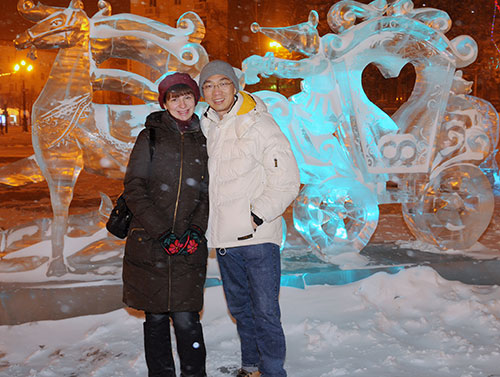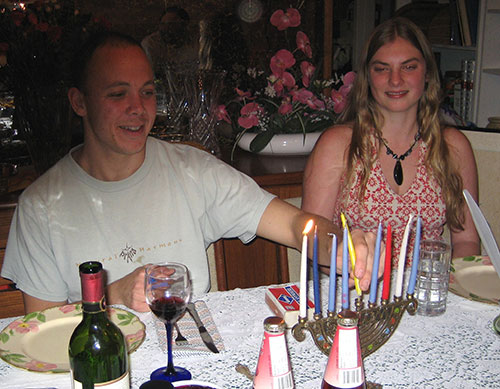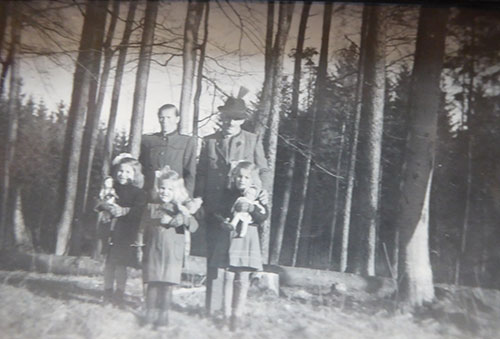


Enjoy these childhood memories of holidays past–Christmas, Hanukkah, and New Year’s celebrations–as shared by Santa Clarans originally from Norway, Mexico, Germany, Russia, Taiwan and California.
Norwegian-born Bendik Kleveland recalls walking around the Christmas tree, holding hands and singing carols. The tradition is still common in Norway, and when he recently visited his father there, he heard the older people talking excitedly about the upcoming “Juletrefest” (Christmas tree party). When he asked his father why it was such a big deal, his father said that they were excited about the possibility of maybe holding hands with someone special as they walked around the tree!
“I remember that as a child the most important [New Year’s] ritual was the ‘eating of the 12 grapes.’ The day of New Years Eve, you better be ready to buy the best grapes you can find in the market, and choose them fresh and juicy to welcome the New Year, ” writes Citlalli Del Carpio, who grew up in Mexico City, Mexico.
At 12 a.m., everyone would eat one grape at each chime of the bell, symbolizing sustenance and abundance in the next 12 months. They sipped a glass of champagne to bring joy.
Then “…you grab a suitcase and go outside your house and walk for a couple of minutes with the suitcase. This symbolizes that you will travel wherever you want during the year. Other traditions are to sweep the house to create a positive environment and to wear red underwear for love,” continues Del Carpio.
“For my grandparents, my aunts and uncles, my mother and father, my cousins, for all of us, it was part of welcoming the New Year! We loved eating grapes, drinking champagne, traveling with suitcases, sweeping the floor. It was fun!” writes Del Carpio.
Elfriede Hull is from the Bavarian city of Ebersberg in southern Germany near Munich. On Christmas Eve, stores closed at noon. People decorated their trees and the Christkind (Christ child) left gifts under the tree. It was just after WWII, so dinner was simple–bratwursts with sauerkraut and bread. Then after opening gifts (a teddy bear and needed clothes for Hull, dolls for her two sisters), they went to Midnight Mass, walking two miles in the snow.
“Sometimes it snowed pretty good,” says Hull. “When we came home from Mass, we hung our wet clothes over the wood stove to dry and maybe warmed up with a little schnapps, even the kids.”
Hull’s mother baked stollen, gingerbread and cookies. Hull brought that tradition to America in 1985. Until she ran out of steam last year, she baked 27 different kinds of Christmas cookies, beginning in mid-November to be finished by Advent. She baked four kinds each day and stored them in tins.
“We were so poor, but we had a nicer childhood than anybody else, nicer than the kids have now. We were happy when we got just one thing. You could run around without being worried somebody would take you. We had fun!” says Hull, adding, “Christmas should be at home.”
Elena Baykova comes from the big city of Khabarovsk in the far east of Russia, closer to Japan than to Moscow. Because the then U.S.S.R. suppressed religion, New Years became (and remains) the most important Russian holiday.
Although they don’t call it a Christmas tree, her family got a live pine from a city marketplace on December 30th or 31st and decorated it. Gifts from Father Frost magically appeared under the tree to be opened on New Year’s morning. New Year’s Eve was an all-night celebration.
“We try to look festive in Russia. We wear heels and evening dresses–even just at home for dinner and dancing,” says Baykova. “You must have champagne to toast the new year!”
At midnight the president spoke on TV. Families watched a famous Russian comedy movie or went to parties, not getting to bed until 4 or 5 a.m. Sometimes Baykova’s family went for a walk in the cold night (-22 degrees F.) and viewed ice sculptures carved by Russian and neighboring Chinese ice sculptors.
“I miss everything–my mom’s cooking, eating dinner together, walking outside in the city, everything,” says Baykova.
Steve Lee, Baykova’s husband, is from Shingchu, once a farm community but now the Silicon Valley of Taiwan.
“New Year’s–the Lunar New Year–is a really big celebration,” says Lee. “Taiwan was very poor when I was small, growing up in the 60s. It was still a farming society, not industrial. In the winter the farmers rested, so they really celebrated. We rarely had meat during the year. Families would save everything for the New Year’s celebration. We had an abundance of food then, and soda, like 7-Up, was a once-a-year treat.”
After a New Year’s Day feast, the children bowed to their parents and were given red envelopes containing money.
“Also, we shot firecrackers at each other, just playing games,” says Lee. “It rained so much there was no fire hazard.”
Travel was not easy then, but on the second day of the Lunar New Year–which falls in late January or in February, Lee’s mother, who by tradition lived with her husband’s family, traveled her parents distant home to be spoiled by them for two days.
Bill Heistein, was born in Mo I Rana, Norway, near the Arctic Circle.
“Up there, you have two weeks of summer, and the rest is rough sleighing,” he says.
At Christmas time, Heistein remembers his father going into the mountains on a dog sled to cut down a Christmas tree. His father ran a dogsled ambulance service. During ski jump competitions, he ferried injured jumpers to where the regular ambulance was waiting.
At the start of Christmas Eve dinner, rice porridge with an almond hidden inside it was served. If you got the almond, you hid it in your mouth and everyone tried to guess who had gotten it. Whoever guessed right, won a marzipan candy pig that Heistein’s mother, Agot, had made.
Gloria Heistein, Bill’s wife, is a native Californian. Her mother, Sylvia Palmer, was Jewish and her father Catholic, so they celebrated both Hanukkah and Christmas. At Hanukkah, her mother made delicious latkes–potato pancakes fried in oil and served with sour cream and applesauce. When lighting the menorah (a candelabrum), she told the story of the Jewish Festival of Lights.
“To me, Hanukkah is a holiday that celebrates Jewish culture and religious freedom. The theme of being free to observe one’s religion is also a key American value, so Hanukkah is recognized as a major holiday in the U.S. that people, regardless of religion, can appreciate,” states Gloria.





